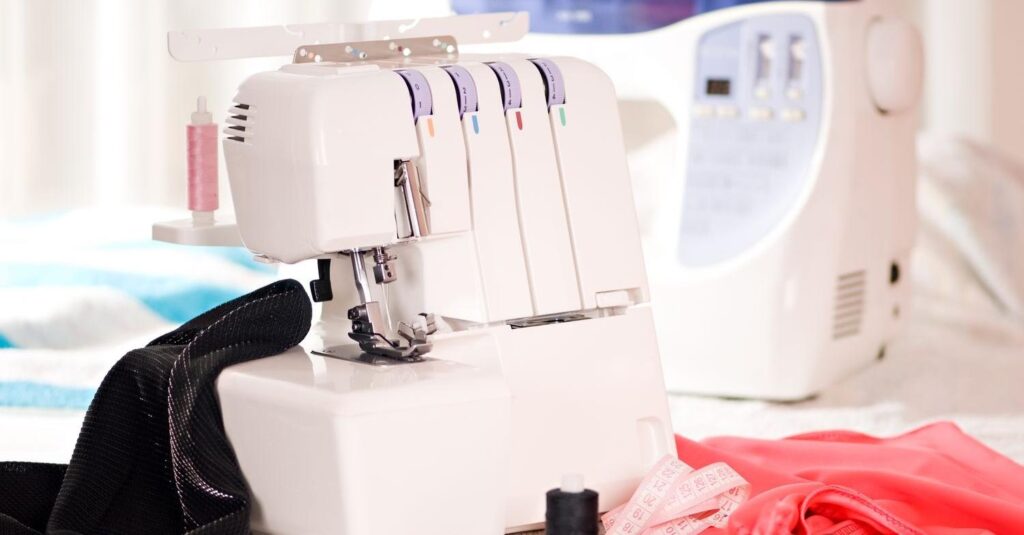Are you curious to know what is a serger? You have come to the right place as I am going to tell you everything about a serger in a very simple explanation. Without further discussion let’s begin to know what is a serger?
The world of sewing is a realm of creativity, where fabrics come to life through the skillful hands of artisans and hobbyists. One tool that has revolutionized the sewing process is the “serger,” also known as an overlock machine. This versatile machine adds a professional touch to garments, finishing edges, and creating secure, polished seams. In this blog, we’ll dive into the world of sergers, understanding their functions, benefits, and their indispensable role in the sewing world.
What Is A Serger?
A serger, short for “overlock serger,” is a specialized sewing machine designed to finish raw fabric edges and create secure, neat seams. It differs from a conventional sewing machine in that it trims excess fabric while simultaneously stitching over the edge, preventing fraying and unraveling. Sergers often use multiple threads and needles to create strong, stretchable seams, making them ideal for sewing knit fabrics and creating durable finishes.
Key Features And Functions
- Finishing Edges: One of the primary functions of a serger is to neatly finish fabric edges to prevent fraying. The machine trims the edge of the fabric and simultaneously sews over it with an overlock stitch, encasing the raw edge within the thread.
- Seam Creation: Sergers are also used to create seams in garments. Depending on the number of threads and needles, they can produce various types of stitches, such as the popular three-thread or four-thread overlock stitches. These stitches are strong and flexible, making them suitable for garments that require stretch.
- Rolled Hem: Many sergers have the capability to create a rolled hem, a delicate and narrow edge finish often seen on ruffles, napkins, and lightweight fabrics.
- Gathering: Some sergers have a gathering or differential feed function that allows you to create controlled gathers or pleats in fabrics.
Benefits Of Using A Serger
- Professional Finish: Sergers produce clean, polished seams and edges that give garments a professional look, even on the inside.
- Durability: The serger’s strong overlock stitches ensure that seams can withstand wear and tear, making it a great choice for active wear, children’s clothing, and stretchy fabrics.
- Time-Saving: The serger’s combined cutting and stitching function saves time compared to manually finishing edges with a regular sewing machine.
- Versatility: While primarily used for finishing edges and sewing seams, sergers can also be used for decorative stitching and creative embellishments.
- Efficient Fabric Usage: The trimming function of a serger reduces fabric waste by cutting away excess material.
Conclusion
The serger is a versatile and indispensable tool in the world of sewing, enabling artisans to elevate their creations with professional finishes, secure seams, and intricate details. Its ability to neatly finish edges, create strong seams, and even gather fabric makes it a staple in both garment-making and home decor projects. Whether you’re a seasoned seamstress or a sewing enthusiast, the serger opens up a world of possibilities for transforming fabrics into beautifully crafted creations.
Learn Benefit About Everything on Whybenefit.
FAQ
What Is The Purpose Of A Serger?
A serger, commonly referred to as an overlock machine, combines three functions into one simple operation-stitching a seam, trimming the excess seam allowance and overcasting the edge of your fabric-allowing you to achieve professional quality stitching in a short amount of time. They are very fast!
Can You Serge On A Regular Sewing Machine?
While you can’t create a true serged edge without a serger, you can recreate the idea and effect with an overlocking foot. The foot helps make the overlocking stitches and pin and ladder stitches possible and secure.
Is A Serger The Same As An Overlocker?
A serger and an overlocker are different names for the same machine. Americans generally refer to these as sergers, and nearly everyone else refers to them as overlockers. A serger performs an overlocking stitch, which is really more like knitting than sewing.
Do I Need A Serger If I Have A Sewing Machine?
A serger is a great companion to a regular sewing machine, but it’s definitely not necessary for everyone and is more useful for certain genres of sewing than for others. Can you sew pretty much anything without a serger? Yes, you absolutely can!
I Have Covered All The Following Queries And Topics In The Above Article
What Is A Serger
What Is A Serger Sewing Machine
What Is A Serger Used For
What Is A Serger In Sewing
What Is A Serger Machine
What Is A Serger Sewing Machine Used For
What Is A Serger Used For In Sewing
What Is A Sewing Serger
What Is A Serger Machine Used For
What Is A Serger For
What Is A Serger Stitch
What Is Differential Feed On A Serger
What Is A Serger Sewing
What Is A Serger?
What Is A Thread Serger
What Is A Sewing Machine Serger
What Is A Cover Stitch On A Serger
What Is A Serger For Sewing
What Is A Rolled Hem On A Serger
What Is A Serger
What is a serger used for?






